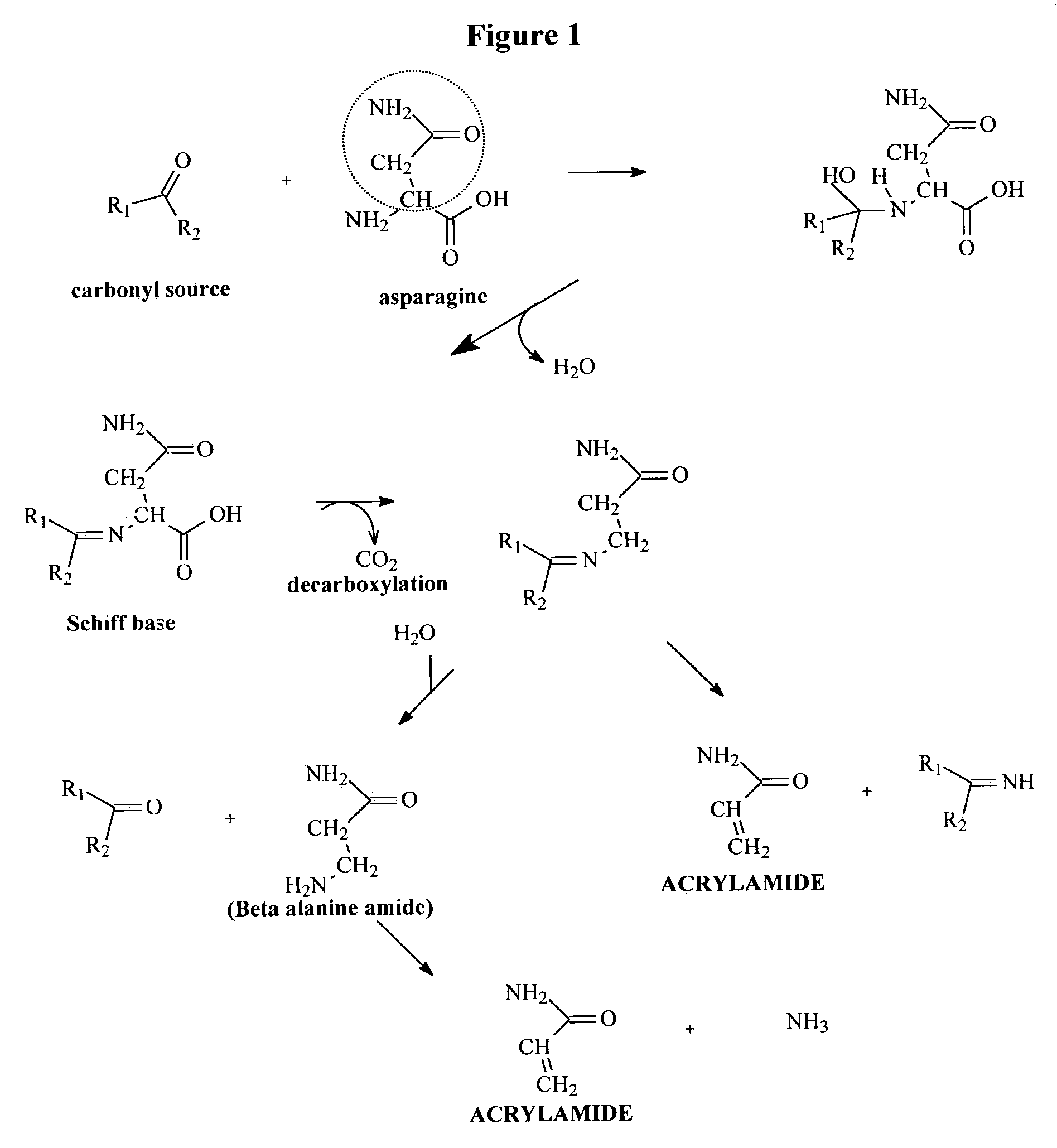Method for reducing acrylamide in foods comprising reducing the level of reducing sugars, foods having reduced levels of acrylamide, and article of commerce
a technology of acrylamide and reducing sugar, applied in the field of acrylamide reduction in food products, can solve the problems of limited human population data available, and achieve the effects of reducing or low levels of acrylamide, and reducing the level of acrylamide in foods
- Summary
- Abstract
- Description
- Claims
- Application Information
AI Technical Summary
Benefits of technology
Problems solved by technology
Method used
Image
Examples
example 1
Dehydrated Potato Product
[0177]Russet baking potatoes are peeled, cut into ⅜ inch thick slabs, rinsed with water then placed in a pot of boiling water. The potatoes are boiled (submerged) for 20 minutes. The boiled potatoes are removed from the water and mashed.
[0178]500 units of glucose oxidase (purchased from Sigma-Aldrich catalog #G7141) are added to 45 ml of water, then added to 15 g of mashed potatoes and thoroughly admixed. The mixture is allowed to incubate for 30 minutes.
[0179]After the 30-minute incubation, the product is microwaved (Panasonic microwave, model NN-S5488A) on high for 2-minute increments for a total of 10 minutes until dry (and brown). Compared to dehydrated potato products prepared by the exact same process but without the enzyme (control sample), the enzyme-treated dehydrated potato product results in greater than a 10% reduction in acrylamide when analyzed for acrylamide using the method set forth herein.
example 2
Potato Chips
[0180]Potato chips having reduced levels of acrylamide can be made using raw potato slices. Peel Atlantic potatoes and slice to ˜1.1 mm thickness. Rinse and pad dry. Blanch potato slices in 165° F. water for fifteen seconds. Cool and drain blanched slices. Soak 100 grams of blanched potato slices in 250 ml of distilled / deionized water containing glucose oxidase, having 1000 units of activity, for one hour. Agitate sample by swirling for 1 minute every 8 minutes. Remove potato slices from the solution and blot dry on paper towels. Fry the potato slices in a fryer set at 375° F. for 60 seconds. Compared to; potato chips prepared by the exact same process but without enzyme addition (control sample), the enzyme-treated potato chips result in greater than a 10% reduction in acrylamide when analyzed for acrylamide using the method set forth herein.
example 3
[0181]French fries having reduced levels of acrylamide can be made using raw potato strips. Peel Atlantic potatoes and cut into strips having a cross-sectional area of about 8 mm×8 mm. Rinse and pad dry. Blanch potato strips in 165° F. water for one minute. Cool and drain blanched strips. Soak 100 grams of blanched potato strips in 250 ml of distilled / deionized water containing glucose oxidase, having 100 units of activity, for one hour. Agitate sample by swirling for 1 minute every 8 minutes. Fry the treated potato strips in a fryer set at 375° F. for 60 seconds to form French fries.
[0182]Compared to French fries prepared by the exact same process but without enzyme addition (control sample), the enzyme-treated French fries result in greater than a 10% reduction in acrylamide when analyzed for acrylamide using the method set forth herein.
PUM
 Login to View More
Login to View More Abstract
Description
Claims
Application Information
 Login to View More
Login to View More - R&D
- Intellectual Property
- Life Sciences
- Materials
- Tech Scout
- Unparalleled Data Quality
- Higher Quality Content
- 60% Fewer Hallucinations
Browse by: Latest US Patents, China's latest patents, Technical Efficacy Thesaurus, Application Domain, Technology Topic, Popular Technical Reports.
© 2025 PatSnap. All rights reserved.Legal|Privacy policy|Modern Slavery Act Transparency Statement|Sitemap|About US| Contact US: help@patsnap.com

